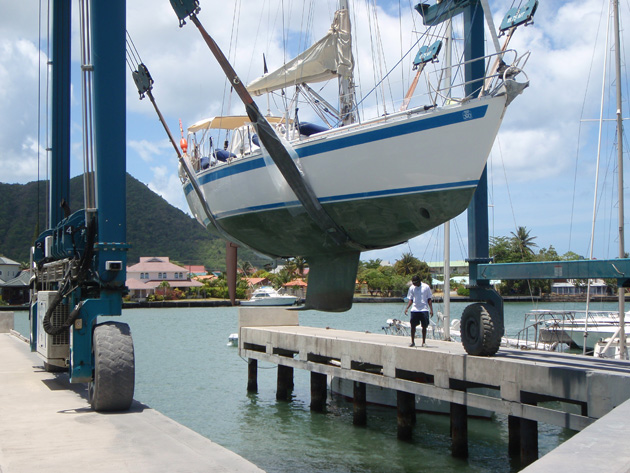When the rudder of his 39-footer broke in mid-Atlantic Patrick Marshall set up a jury rig, with the support and advice of a radio net, and sailed 1,500 miles to the Caribbean
Approaching land
On the afternoon of the 29th, with the seas building and the sky looking threatening, we made the decision to stow the spinnaker poles and staysail and make the final approach with a small amount of genoa assisted by the engine. We knew by now that the usual laws of sailing no longer applied, and that Egret would go best downwind with the genoa sheeted in hard rather than eased.
 The wind and seas continued to increase through the night, with the biggest gust at 38 knots. We reduced our watches to two hours, spending most of that time perched in the companionway, ready to winch in one or other of the steering lines to bring Egret back on course should a big gust send her careering off towards either island.
The wind and seas continued to increase through the night, with the biggest gust at 38 knots. We reduced our watches to two hours, spending most of that time perched in the companionway, ready to winch in one or other of the steering lines to bring Egret back on course should a big gust send her careering off towards either island.
We arrived at our waypoint an hour early, but the lights from Martinique had been visible for some time. We were surprised to hear Egret’s name being called over the VHF; it was the Martinique branch of the French Coastguard saying that they had been tracking us on behalf of Falmouth Coastguard, and asking us to report back to them on arrival. It was comforting to know that they were keeping an eye on us.
We altered course to the south and as the day brightened the peaks of Saint Lucia became more defined under the stormy sky. The familiar voice of Jo suddenly came over the radio to give us encouragement for the final few miles. The boatyard manager was ready to send out a launch to tow us in.
The seas remained very steep until we rounded Pigeon Island into the shelter of Rodney Bay. Jo and Arny greeted us with a bag of fresh bread and fruit, then helped us to recover the drogue and take our tow line across to Lucky Strike, which towed us to our berth in the marina. What a welcome end to 26 eventful days across 2,200 miles of ocean – and just in time to celebrate New Year!
Our recommendations
- Try to be part of an SSB radio net for both moral and practical support.
- Make sure that you take adequate rest periods once you have the situation under control.
- Be patient, and accept that arriving late doesn’t matter as long as you reach a safe harbour eventually.
- Remember that the rudder provides part of the lateral resistance of the hull, so once it is missing, the boat will be very unbalanced. We doubted that any sort of steering oar or vane gear rudder would have been effective.
- Have an understanding of the construction of your rudder and its likely mode of failure.
- Start working out how to obtain a replacement rudder and where it could be fitted as early as possible.
- When conditions are suitable, experiment with different sail plans and sailing at various angles to the wind in order to help you deal with situations later on.
- Notify Falmouth Coastguard as soon as possible, who will take regular position reports from you and pass them on to the local services.
- Be careful not to seek the assistance of too many people who might overload your capacity to receive emails. (Sailmail did allow us extra airtime free of charge on request).
POSTSCRIPT: Our insurers’ surveyor, after examining the fracture, agreed that we must have collided with something substantial – maybe a semi-submerged shipping container. We could probably have had a rudder made locally incorporating the remains of the old shaft, but for the long term we really wanted a new one built to the builder’s original specifications.
Fortunately, Sweden Yachts still had the drawings and moulds and were willing to make a replacement. Our insurers agreed that this would be the best course of action, but the downside was that it would be eight weeks before the new rudder reached Saint Lucia and then it would still have to be fitted and antifouled before we could get sailing again.
It was air-freighted to us and, like all the best presents, was packed in a large, heavy and beautifully made box. The rudder was perfect and slotted straight into position. On Tuesday 10 April, four months after breaking our rudder, we checked out of Customs to continue our cruise.
 Patrick Marshall started cruising with his parents and team racing at Southampton University. He first made his mark on the National Solo open meeting circuit.
Patrick Marshall started cruising with his parents and team racing at Southampton University. He first made his mark on the National Solo open meeting circuit.
After joining Hayling Island Sailing Club, he switched to the International 10m2 Canoe and won two National Championships and a bronze in the Worlds.
He campaigned a Bull 7000 in the Solent then restored an Aphrodite 101. He and his wife Amanda bought their current Sweden 390 to extend their cruising.






